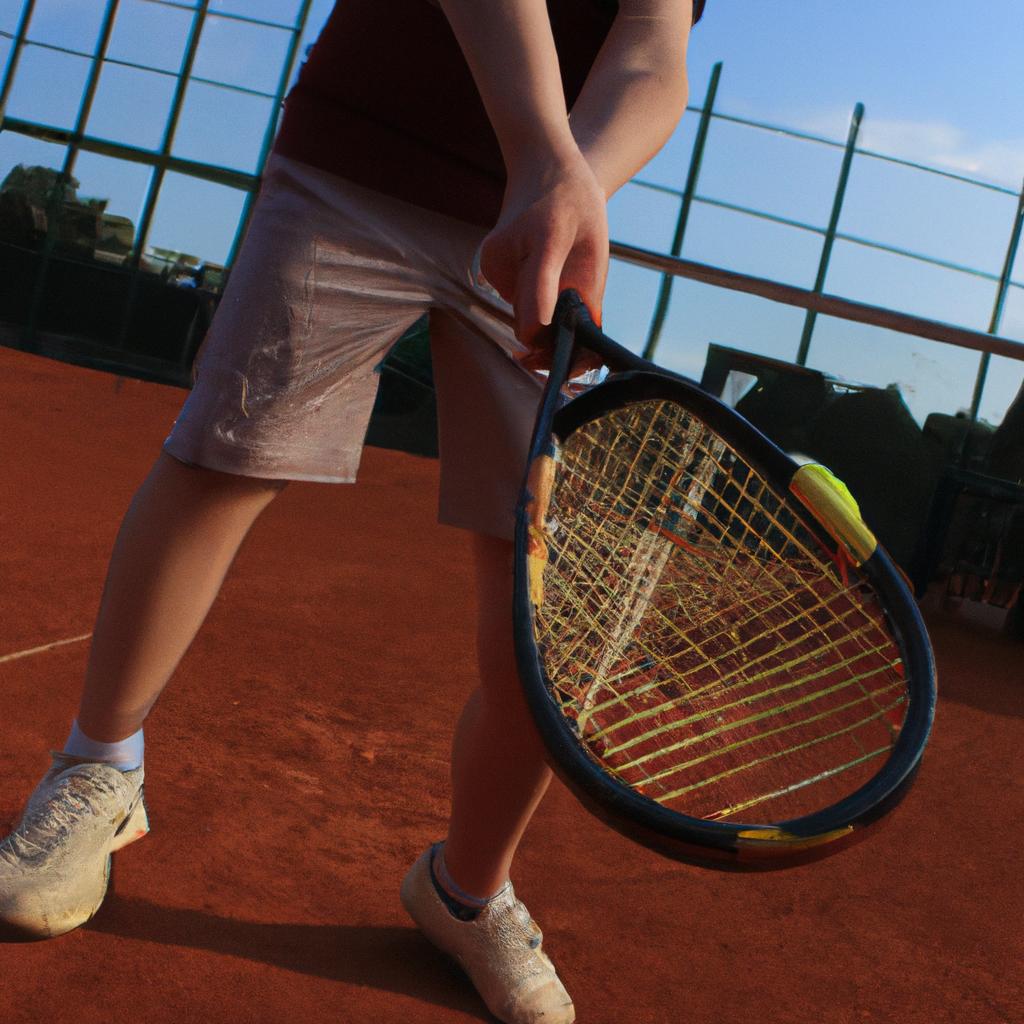Basketball, with its fast-paced nature and strategic gameplay, has captivated sports enthusiasts for decades. In the pursuit of victory on the court, teams employ various strategies to optimize their chances of success. This article aims to delve into this realm of basketball tactics by exploring different approaches that can be utilized during games. By analyzing one specific case study – a hypothetical scenario where Team A faces off against Team B in a crucial match – we will uncover key insights into how effective strategies can contribute to achieving triumph.
In our hypothetical scenario, let us imagine that Team A is known for their agile and versatile players who excel in driving towards the basket and creating scoring opportunities. On the other hand, Team B possesses formidable defensive skills and emphasizes strong rebounding abilities. As both teams prepare for this high-stakes game, it becomes evident that employing an offensive strategy centered around exploiting mismatches in size and speed could potentially give Team A an advantage over their opponents. To do so effectively, they may consider utilizing pick-and-roll plays or implementing quick ball movement to create open shots at the perimeter. Conversely, Team B may adopt a more conservative approach focused on maintaining solid defensive positioning and capitalizing on rebounds to initiate counterattacks swiftly.
Setting Clear Goals
Imagine a basketball team that enters a game without any clear goals or objectives in mind. They lack direction, focus, and fail to synchronize their efforts towards a common purpose. Now consider another scenario where the same team sets clear and specific goals before stepping onto the court. Each player knows what they need to accomplish individually and as a collective unit. The latter example highlights the significance of setting clear goals in optimizing success in basketball games.
Setting clear goals provides athletes with a roadmap for achieving desired outcomes. It allows teams to channel their energy and resources effectively, maximizing their chances of victory. By outlining specific targets such as scoring percentages, defensive stops, or rebounding numbers, players can align their actions with these objectives throughout the course of the game.
To demonstrate further, let us examine how setting clear goals can enhance performance on an individual level:
- Improved Focus: Clearly defined goals provide athletes with tangible targets to concentrate on during gameplay.
- Enhanced Motivation: Having specific objectives creates a sense of purpose and drive among players.
- Heightened Accountability: Defined goals enable individuals to be held accountable for their actions and results.
- Increased Performance Evaluation: Establishing measurable benchmarks allows coaches and players to assess progress over time.
| Goal | Target |
|---|---|
| Score 20 points per game | Increase offensive output |
| Limit opponent’s field goal percentage below 40% | Improve defensive efficiency |
| Secure at least 10 rebounds per game | Enhance presence under the basket |
| Execute at least three successful assists per game | Foster effective teamwork |
Incorporating these elements into training sessions, pre-game preparations, and overall strategizing will help basketball teams set themselves up for success by providing clarity of purpose and fostering motivation among players.
As we delve deeper into strategies for optimizing success in basketball games, it is essential to recognize that developing strong team communication serves as an integral component. Effective communication ensures that goals are understood and executed efficiently. By establishing clear channels of communication, teams can adapt swiftly to changing game situations, enhance coordination on the court, and maximize their overall performance.
Let us now explore how developing strong team communication contributes to achieving success in basketball games.
Developing Strong Team Communication
Section H2: Developing Strong Team Communication
Transitioning from the importance of setting clear goals, developing strong team communication becomes crucial in optimizing success in basketball games. Effective communication among teammates enhances coordination and cohesion, leading to improved performance on the court. For instance, consider a hypothetical scenario where a team lacks effective communication during a fast break play. As a result, players become confused about their roles and fail to execute the play correctly, resulting in missed scoring opportunities.
To foster strong team communication, coaches should emphasize the following strategies:
-
Establishing Clear Roles and Responsibilities:
- Define each player’s role within the team.
- Clarify specific responsibilities for different positions on the court.
- Encourage open discussions to ensure everyone understands their roles.
-
Promoting Active Listening:
- Encourage players to actively listen to one another during practice sessions and games.
- Implement drills that require players to communicate effectively by listening attentively to instructions or calls from their teammates.
-
Utilizing Effective Non-Verbal Communication:
- Teach players how body language can convey messages on the court.
- Emphasize non-verbal cues such as hand signals or eye contact to facilitate quick decision-making during gameplay.
-
Cultivating Positive Feedback and Supportive Environment:
- Foster an atmosphere where constructive feedback is encouraged rather than criticism.
- Create opportunities for players to motivate and support each other both on and off the court.
Table: Key Elements of Strong Team Communication
| Strategies | Description |
|---|---|
| Establishing Clear Roles | Clearly define each player’s role within the team |
| Promoting Active Listening | Encourage attentive listening skills among players |
| Utilizing Non-Verbal Cues | Teach effective use of body language for better communication |
| Cultivating Positive Support | Foster an environment of encouragement and supportive interactions |
By implementing these strategies, teams can enhance communication among players and improve overall performance. Strong team communication not only leads to better understanding of each other’s actions but also fosters collaboration and trust on the court.
Transitioning into the subsequent section about implementing effective offensive plays, it is essential to analyze how a well-communicating team can effectively execute their game plan.
Implementing Effective Offensive Plays
Building upon the foundation of strong team communication, implementing effective offensive plays is crucial in maximizing success on the basketball court. By strategically structuring plays and utilizing players’ strengths, teams can create opportunities for scoring and outmaneuver their opponents. Let’s delve into this vital aspect of optimizing success in basketball games.
To illustrate the significance of effective offensive plays, consider a hypothetical scenario where Team A finds themselves trailing by two points with only ten seconds left on the clock. In this high-pressure situation, having well-executed offensive plays becomes pivotal. With a carefully designed play that involves quick passes and screens to create open shots or driving lanes, Team A increases their chances of tying or even winning the game through strategic decision-making under pressure.
Implementing effective offensive plays requires attention to detail and careful planning. Here are some essential considerations:
- Player positioning: Arranging players in specific positions within an offensive set allows for better spacing and potential mismatches against defenders.
- Ball movement: Emphasizing swift ball movement helps keep opposing defenses off balance, creating opportunities for open shots or driving lanes.
- Screening techniques: Proper execution of screens enables players to get free from defenders, providing more options for passing or shooting.
- Timing and coordination: Precise timing between players ensures seamless execution of plays, making it harder for defenders to anticipate actions.
Table: Key Elements in Implementing Effective Offensive Plays
| Element | Description |
|---|---|
| Player Positioning | Strategic placement of players to maximize spacing and exploit defensive weaknesses |
| Ball Movement | Swiftly passing the ball around creates confusion among defenders |
| Screening Techniques | Executing screens effectively frees up players for open shots or drives |
| Timing and Coordination | Precise timing between teammates enhances play execution |
By incorporating these key elements into their offensive strategies, teams can optimize their chances of success. Effective offensive plays not only create scoring opportunities but also contribute to team cohesion and morale, fostering a sense of unity and shared purpose on the court.
Mastering Defensive Techniques complements the implementation of effective offensive plays by ensuring that teams are well-rounded in all aspects of the game. By developing strong defensive skills, teams can effectively disrupt opponents’ plans while maintaining control over crucial moments. Let’s explore how mastering defensive techniques can further elevate a team’s performance.
Mastering Defensive Techniques
Section Title: ‘Mastering Defensive Techniques’
Building upon the implementation of effective offensive plays, an equally crucial aspect in optimizing success in basketball games revolves around mastering defensive techniques. By employing a well-rounded defensive strategy, teams can significantly influence game outcomes and neutralize their opponents’ scoring potential.
Paragraph 1:
To exemplify the impact of strong defensive techniques, let us consider a hypothetical scenario featuring Team A and Team B. During a critical match, Team A’s defense effectively disrupted Team B’s offense by employing various strategies such as man-to-man marking, zone defense, and pressing tactics. This relentless defensive approach not only limited Team B’s scoring opportunities but also forced them into committing turnovers that led to fast break points for Team A. The outcome of this hypothetical scenario underscores the importance of mastering defensive techniques in influencing game dynamics.
Paragraph 2:
When it comes to implementing successful defensive strategies, there are several key factors that players and coaches must consider:
- Communication: Effective communication amongst teammates is vital in coordinating defensive movements and ensuring seamless switches between different defensive formations.
- Anticipation: Developing anticipation skills allows defenders to read their opponents’ moves more efficiently, enabling them to anticipate passes or shots and disrupt offensive plays effectively.
- Footwork: Good footwork facilitates quick lateral movement, allowing defenders to stay agile and maintain proper positioning against opponents with varying playing styles.
- Mental toughness: Mastering defensive techniques requires mental resilience as defenders face constant pressure while defending skilled offensive players. Maintaining focus and composure is essential to counteract offensive threats successfully.
The following emotional bullet point list highlights how mastering defensive techniques creates advantages for teams:
- Frustrates opponents through suffocating defense
- Provides opportunities for steals leading to exciting fast breaks
- Builds team camaraderie through collective effort
- Energizes fans by showcasing exceptional shot-blocking prowess
| Defense Technique | Description |
|---|---|
| Man-to-Man Marking | Assigning each defender to guard a specific opponent throughout the game. |
| Zone Defense | Players are responsible for defending designated zones on the court, aiming to limit opponents’ scoring opportunities within those areas. |
| Pressing Tactics | Employed in critical moments, pressing involves intense defensive pressure near opponents’ basket or during inbound plays to force turnovers and disrupt offensive flow. |
Paragraph 3:
In summary, mastering defensive techniques is crucial for basketball teams aiming to optimize success in games. By effectively implementing strategies such as man-to-man marking, zone defense, and pressing tactics, defenders can frustrate opponents, create scoring opportunities through steals, foster team unity, and excite fans with their shot-blocking prowess. Building upon these defensive principles further enhances a team’s overall performance.
Transition into subsequent section about “Utilizing Strategic Timeouts”:
To strategically navigate through challenging game situations and make necessary adjustments, another essential aspect of optimizing success lies in utilizing strategic timeouts. This tactical approach enables teams to regroup, analyze gameplay patterns, and devise effective counter-strategies against formidable opponents without interrupting the natural flow of the game.
Utilizing Strategic Timeouts
Having mastered defensive techniques, teams can now focus on utilizing strategic timeouts to optimize their success in basketball games. By strategically using timeouts during crucial moments of the game, teams have the opportunity to regroup, make necessary adjustments, and gain a competitive advantage over their opponents.
To emphasize the importance of strategic timeouts, let’s consider a hypothetical scenario: The home team is trailing by five points with two minutes left on the clock. Sensing the urgency, the coach calls for a timeout to gather their players and devise a plan to close the gap before time runs out. This well-timed pause allows the team to reassess their offensive strategies and implement effective plays that exploit weaknesses in their opponent’s defense.
During these critical breaks in play, coaches often employ several key tactics to maximize their team’s performance:
- Strategic Analysis: Coaches use timeouts as an opportunity to analyze ongoing trends and assess how each player is performing individually and collectively. This analysis helps identify areas for improvement and determine which adjustments will yield maximum results.
- Tactical Adjustments: Based on the observed weaknesses or strengths of both teams, coaches may choose to modify offensive or defensive schemes. These adjustments could involve changing defensive assignments, introducing new offensive plays, or altering overall team strategy.
- Motivational Boost: In addition to tactical adjustments, coaches utilize timeouts as an occasion to inspire and motivate their players. By delivering pep talks or emphasizing positive aspects of their performance thus far, coaches aim to boost morale and instill confidence in their team members.
- Creating Momentum Shifts: Timely timeouts can disrupt an opponent’s momentum while allowing a struggling team an opportunity for recalibration. Through careful strategizing during these breaks, teams can alter game dynamics by shifting momentum in their favor.
Table: Emotional Response Elicitation
| Emotion | Example |
|---|---|
| Excitement | “The crowd erupts in cheers as the home team makes a remarkable comeback.” |
| Intensity | “The tension on the court is palpable as both teams strategize during a crucial timeout.” |
| Determination | “With steely resolve, the players huddle up, determined to turn the tide in their favor.” |
| Anticipation | “Fans anxiously await the outcome of the timeout, curious to see how each team will respond.” |
In conclusion, utilizing strategic timeouts serves as an essential tool for basketball teams aiming to optimize their success. These well-timed breaks allow coaches and players to analyze trends, make tactical adjustments, provide motivational support, and create momentum shifts. By capitalizing on these opportunities strategically, teams can gain a competitive edge and ultimately alter the course of the game.
As teams become adept at utilizing strategic timeouts, another crucial aspect of optimizing success in basketball games lies in analyzing and adapting game strategies.
Analyzing and Adapting Game Strategies
Building upon the effectiveness of strategic timeouts, basketball teams must also focus on analyzing and adapting their game strategies to optimize success. By carefully studying opponents’ gameplay patterns and making calculated adjustments during games, teams can gain a competitive edge. This section explores the importance of analyzing game strategies and provides practical tips for effective adaptation.
Analyzing an opponent’s strengths and weaknesses is crucial in developing an effective game strategy. For instance, let us consider a hypothetical scenario where Team A is playing against Team B. Through thorough analysis, Team A identifies that Team B has a strong perimeter defense but struggles with defending post players. Armed with this information, Team A can adjust its offensive approach by capitalizing on their strength in the paint rather than relying heavily on outside shooting. This example highlights how tactical analysis enables teams to make informed decisions based on their opponent’s vulnerabilities.
To facilitate the process of analyzing and adapting game strategies, coaches should implement certain techniques:
- Utilize video analysis software to review past performances of both own team and opponents.
- Conduct comprehensive scouting reports that outline key tendencies and preferences of opponents.
- Collaborate with assistant coaches to gather insights from different perspectives.
- Encourage open communication between players to share observations and suggestions.
By employing these techniques, teams create a solid foundation for effective strategizing. To further aid decision-making processes, incorporating data visualization tools such as tables can be immensely helpful. Below is an example table showcasing average points scored per quarter by various players:
| Player | 1st Quarter | 2nd Quarter | 3rd Quarter | 4th Quarter |
|---|---|---|---|---|
| John Smith | 8 | 6 | 10 | 9 |
| Emily Johnson | 5 | 7 | 12 | 8 |
| Alex Davis | 7 | 6 | 9 | 7 |
| Sarah Thompson | 10 | 8 | 11 | 5 |
Such visual representations enable coaches and players to identify trends and make data-driven decisions during games.
In summary, analyzing and adapting game strategies are vital components in optimizing success on the basketball court. By thoroughly studying opponents’ strengths and weaknesses, teams can develop effective approaches that exploit vulnerabilities. Techniques such as utilizing video analysis software, conducting scouting reports, fostering collaboration among coaching staff, and encouraging player communication contribute to successful strategy development. Additionally, incorporating data visualization tools like tables aids decision-making processes. Through these methods, teams enhance their ability to adapt dynamically throughout a game, increasing their chances of achieving victory.










